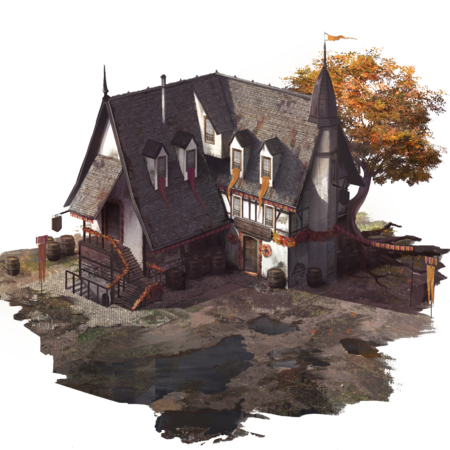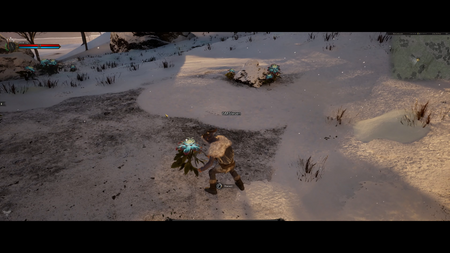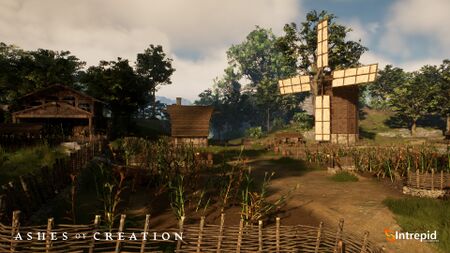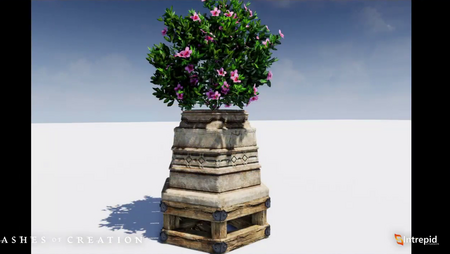“Crops”的版本间差异
(Add section) |
(Change section) |
||
| 第14行: | 第14行: | ||
{{Farmhands and NPC assistance}} | {{Farmhands and NPC assistance}} | ||
| − | == | + | == House plants == |
| − | {{ | + | {{House plants}} |
== See also == | == See also == | ||
2022年5月29日 (日) 19:58的版本
Crops are harvestable resources in Ashes of Creation.[2][3][4][5][6]
- 個人土地房 allow placement of farm workstations for farming crops and livestock.[2][2][3][4][7][6][5]
- The level and types of processing stations on a freehold will affect the speed and quality of crop rotations.[8][2]
- 固定房屋 allows placement of small garden sections for farming special types of crops.[3][4][9]
- 公寓 allow placement of pots to grow seeds.[10][4]
- Public spaces in nodes allow lower-tier animal husbandry and farming activities.[11]
- There'll be different types of tools and/or machinery that can be used to plant multiple seed types within a particular infrastructure that gives you bundles and/or many different harvestings that's part of progression. So, as you get more adept at farming, you have the ability to mass produce; and the same is true when you talk about quantity, speed of processing across many of the different processing professions[8] – Steven Sharif
- Crops are grown from seeds that are obtained from vendors or in the open-world.[12][2]
- Initially seeds will need to be planted individually, but the acquisition of farming tools or hired farmhands will enable more efficient methods.[13]
- Crops must be watered and fertilized until they are mature.[14][12]
- Plants can be uprooted, fruited (seeded), or harvested.[14]
- There are diminishing returns from harvesting crops, where new seeds will eventually need to be reacquired from the world.[15]
- There won't be a breeding mechanic associated with crops.[16]
- Farmable crops have applications beyond basic food items.[17]
- Farmed materials can be processed into craftable materials or be converted directly into consumable items through professions such as cooking and alchemy.[3]

While many families have humble gatherings amongst themselves during this time of the year, the Shadeless Tree is an ancient, venerated establishment that wishes to spread this joy to weary travelers. Here, merchants, adventurers, and citizens bereft of a place to be for the Verdant Keeper's feast may stay, exchanging stories, singing songs, and making friends. Though an already lively place to be, during the Keeper's celebrations the tavern is especially alight with joy and many are urged to join in the festivities - provided they do not rock the tavern, so to speak.[18]
The Verdant Keeper... are a sect of people that keep track of all the things that are necessary to have successful crops and to grow things and to make sure that the cultivation of these things allows a society or civilization to keep growing. So in the transition from Verra to Sanctus these people had to relearn how to grow things without magic. There were druid like people before and now we have to go to this place where there's no magic to support those things. So they spend their time learning about the world and learning about it in sort of a scientific way and keeping track of all of these seasons of the different years, of the decades, of the centuries that go by to sort of create a map for themselves and for the civilizations that they support: Kind of a means to be successful in growing crops and keeping people healthy and happy.[19] – Jeffrey Bard
As the months come and go, and the hand of winter looms over the land, various farmers of Verra take time to celebrate the fortune granted to them by the Verdant Keeper. Hearths are stoked, candles are lit, and fragrant delicacies are prepared. A massive celebration of food and drink takes place, marking the culmination of their hard work and preparation for the harsh, cold months to come. Should the celebrations go well, they say the Keeper will bless the next spring with a brand new harvest, ready to be plucked.[20]
Seasonal resources

If a particular region moves into a season and that week you can't grow a particular type of good, but another region halfway across the world can grow that good; and you talk about moving those goods across regions so that they're relevant to either craft workbenches or you can sell them in the local economies: That is a major indicator of movement of goods and movement of goods carries risks; and risks can create political foes and friends... Something as simple as just a climate can have cascading consequences across the entirety of the game.[22] – Steven Sharif
Seasons affect crops and other herbology resources available for gathering or planting, including how crop rotation is managed.[23][24][25][26]
- Seasonal variations in resource availability will impact the economy and necessitate the transit of goods between different regions.[24]
- One of the things that is huge about the season system and how it affects crops and the gatherables in the game is the impact it will have on the economy. When a particular area no longer is capable for a week's period of time, or even potentially longer, of producing a certain type of crop or harvestable; and that has to change across the world regionally, now the transit system of those materials of those gatherables they become more relevant, and they're subject to potential risk; and the prices might go up in certain areas. It is something that is actually very instrumental in the overall design of the economy in the game.[24] – Steven Sharif
- Seasons may not directly affect certain gatherables, such as veins of ore, but access to those resources may be blocked during certain weather conditions.[23][24]
- It won't likely affect too much on certain resource spectrums like veins of ore. Those might not be affected by the seasons or weather systems, but there might be blockages to cave networks that house those types of ore veins. Alternatively it is going to be significant impact on any type of herbology or plant-based types of gatherables. It's going to have significant impacts on crops that players can plant themselves on their properties; and that they'll be able to harvest. They're going to need to time the crop placement and its maturity window so that it's harvestable and available to be harvest before the change of seasons that might adversely affect certain types of crops. And not every biome will experience the same type of effects caused by the seasonality of the world. The desert biome might instead of snow have significant more winds that pick up that could be damaging to more fragile types of crops if you have a freehold in that location.[23] – Steven Sharif
Underrealm resources
資源 will be different in the Underrealm, including unique species of fish.[27][28][29]
- This will affect professions such as fishing, farming, and animal husbandry.[27][29]
- Since players may only have one Freehold, they must choose their Artisan specializations accordingly if they wish to place it in the Underrealm.[29]
#REDIRECT MediaWiki:Farmhands/zh
根據節點種類和發展進度,玩家將可以聘請農場工人 NPC 在個人土地屋的農場工作。玩家將可以在遊戲內,或透過手機程式或網頁命令工人。[30][31]
House plants
- House plants may be available as housing decor items.[4]
- 公寓 will allow placement of pots to grow seeds.[10][4]
- Potted plants may yield unique items if the plant is properly maintained.[4]
其他
引用
- ↑ X.com - Verran screenshots.
- ↑ 2.0 2.1 2.2 2.3 2.4 影片, 2023-06-30 (6:39).
- ↑ 3.0 3.1 3.2 3.3 訪談, 2021-02-07 (42:41).
- ↑ 4.0 4.1 4.2 4.3 4.4 4.5 4.6 直播, 2020-10-30 (44:22).
- ↑ 5.0 5.1 直播, 2017-05-05 (32:11).
- ↑ 6.0 6.1 直播, 2017-05-30 (20:01).
- ↑ 直播, 2017-10-16 (56:42).
- ↑ 8.0 8.1 直播, 2023-06-30 (1:47:33).
- ↑ 直播, 2020-06-26 (45:32).
- ↑ 10.0 10.1 訪談, 2023-07-09 (41:22).
- ↑ 訪談, 2023-07-09 (51:26).
- ↑ 12.0 12.1 影片, 2023-06-30 (11:53).
- ↑ 訪談, 2023-09-10 (29:31).
- ↑ 14.0 14.1 直播, 2023-06-30 (1:46:24).
- ↑ 訪談, 2023-07-09 (55:54).
- ↑ 訪談, 2021-02-07 (44:17).
- ↑
- ↑ 18.0 18.1 Ashes of Creation Store: Shadeless Tree Tavern.
- ↑ 直播, 2019-10-31 (14:13).
- ↑ Blog: Bounties of the Verdant Keeper.
- ↑ 影片, 2022-10-28 (19:10).
- ↑ 直播, 2022-04-29 (56:24).
- ↑ 23.0 23.1 23.2 直播, 2022-05-27 (55:47).
- ↑ 24.0 24.1 24.2 24.3 影片, 2022-05-27 (15:50).
- ↑ 直播, 2017-05-08 (20:27).
- ↑
- ↑ 27.0 27.1 直播, 2023-04-07 (27:30).
- ↑ 成绩单, 2022-11-05 (10:46:47).
- ↑ 29.0 29.1 29.2 直播, 2017-06-01 (24:30).
- ↑ 直播, 2017-05-09 (28:57).
- ↑ 直播, 2017-11-17 (11:00).
- ↑ 直播, 2021-09-24 (1:03:18).


